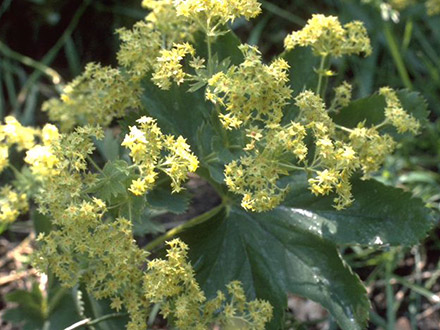Botanical name
Alchemilla vulgaris L. s.l.
Family
Rosaceae
Common name
Nine hooks, Bear's foot, Lion's foot.
Information about the plant
Alchemilla vulgaris is a species-rich plant with several microspecies that are difficult to distinguish from one another. This is why it is appropriately labelled with the suffix s.l. (sensu latiore = in the broader sense). The common lady's mantle is widespread throughout the northern hemisphere and is found in Europe from the Mediterranean to Iceland. It is a 30 to-50 cm tall semi-rosette perennial with very characteristic basal leaves, which have a rounded, folded blade featuring 7 to 9 semicircular lobes. The shape resembles a cape as worn by Mary in holy images. Since the plant was formerly used in gynecology, it was named lady's mantle. The yellow flowers are very small and clustered in richly flowering inflorescences.
The genus name, Alchemilla (= small alchemist, alchemist herb) probably originates from Arabic (al-Kimiya = chemistry). It refers to the water droplets that emerge from the hydathodes along the leaf’s edges in the early morning through a process of guttation (often erroneously described as "dew"), which then flow together in a funnel-shaped leaf base to form a large pearl. Alchemists have attributed special healing powers to these droplets.
Medicinally used parts of plants (herbal drug)
The dried aerial parts consisting of leaves, flowers, and stems collected during flowering time are used. The commercially available drug is sourced from cultivations in Eastern and Southern European countries.
Constituents of the herbal drug
Lady's mantle contains tannins (mainly ellagitannins) and flavonoids.
Quality of the drug
The quality of the lady's mantle herb (Alchemilla herba) is specified in the European Pharmacopoeia (Ph. Eur.).
Medical applications
Recognised medical use
Lady's mantle herb has not been evaluated by the HMPC.
ESCOP: As an adjuvant for non-specific diarrhea, gastrointestinal complaints, and menstrual pain. These indications are based on human experience and long-standing use.
Traditional use
Lady's mantle herb has not yet been classified as a traditional medicinal product (Article 16a of Directive 2001/83/EC). Lady's mantle herb, in combination with other drugs, is used to improve general well-being.
Herbal drug preparations in finished dosage forms
Cut drug for tea preparation.
Dosage
Finished medicinal product: see patient information leaflet.
Tea: Drink a cup of lady’s mantle tea several times a day between meals. Average daily dose of 5g to 10g of the drug.
Preparation of a tea
Pour 150 ml of boiling water over 1 to 2g finely chopped lady’s mantle herb and strain after 10 minutes.
Notes
A visit to the doctor is recommended after 3 to 4 days of persistent diarrhea. Currently, there are no safety studies available for its use during pregnancy and lactation, or in children under 12 years of age.
Side effects
None known.
Interactions
None known.
References
Herbal drug monographs
ESCOP (2013)
Further literature
Commentary on the European Pharmacopoeia (Lady's Mantle herb, No. 1387)


